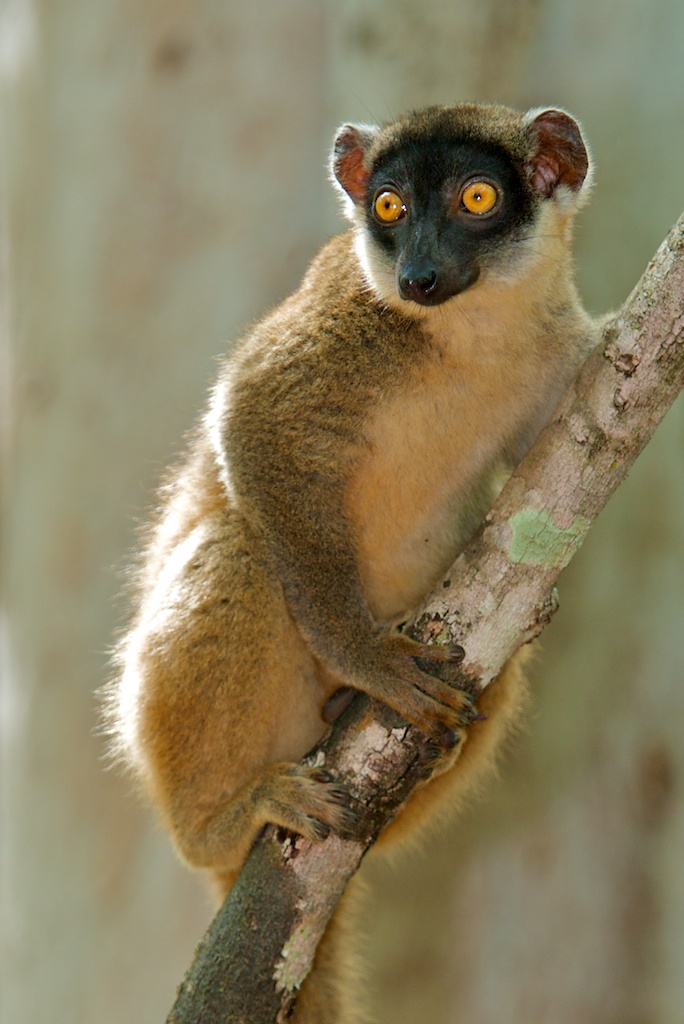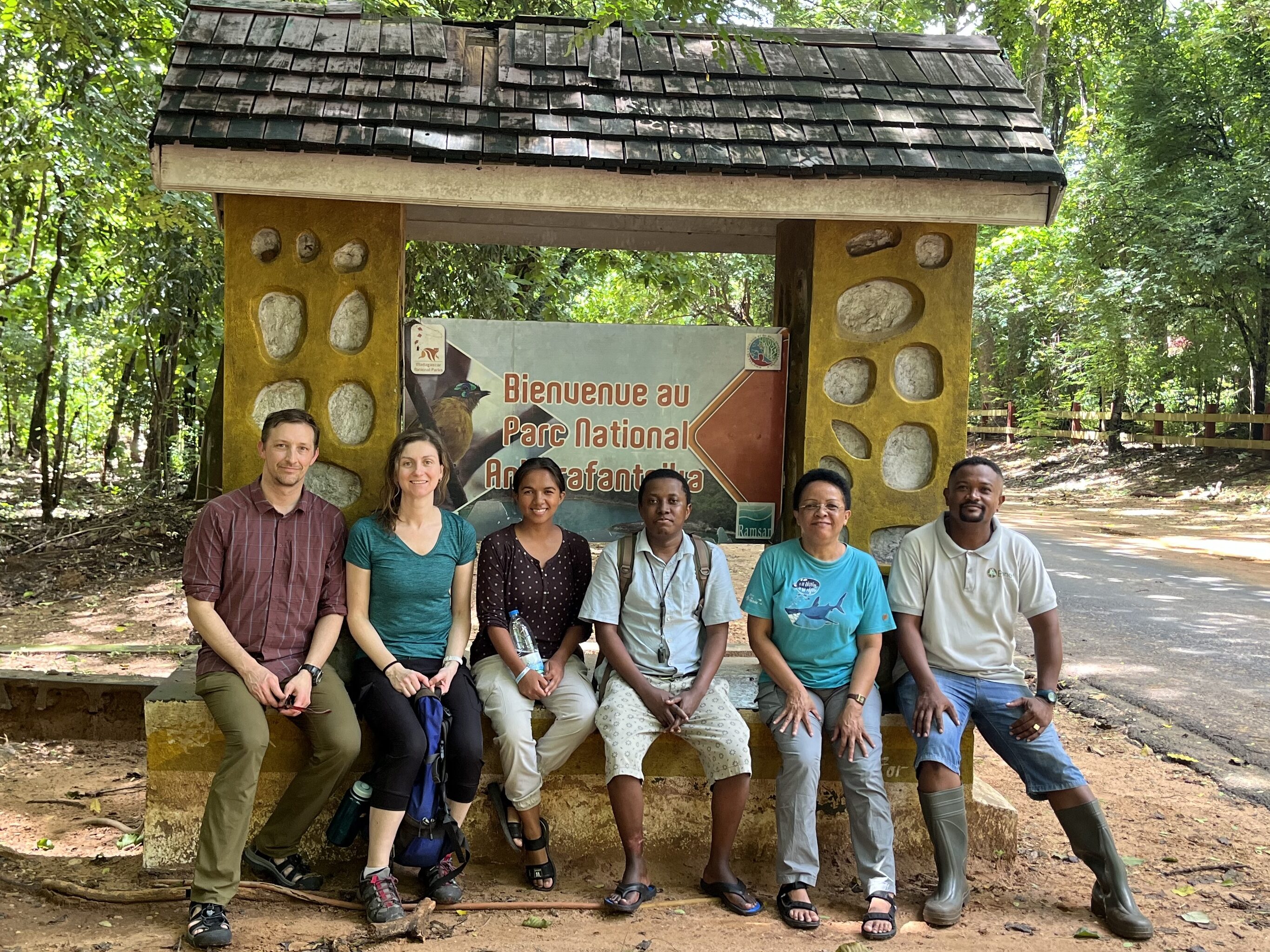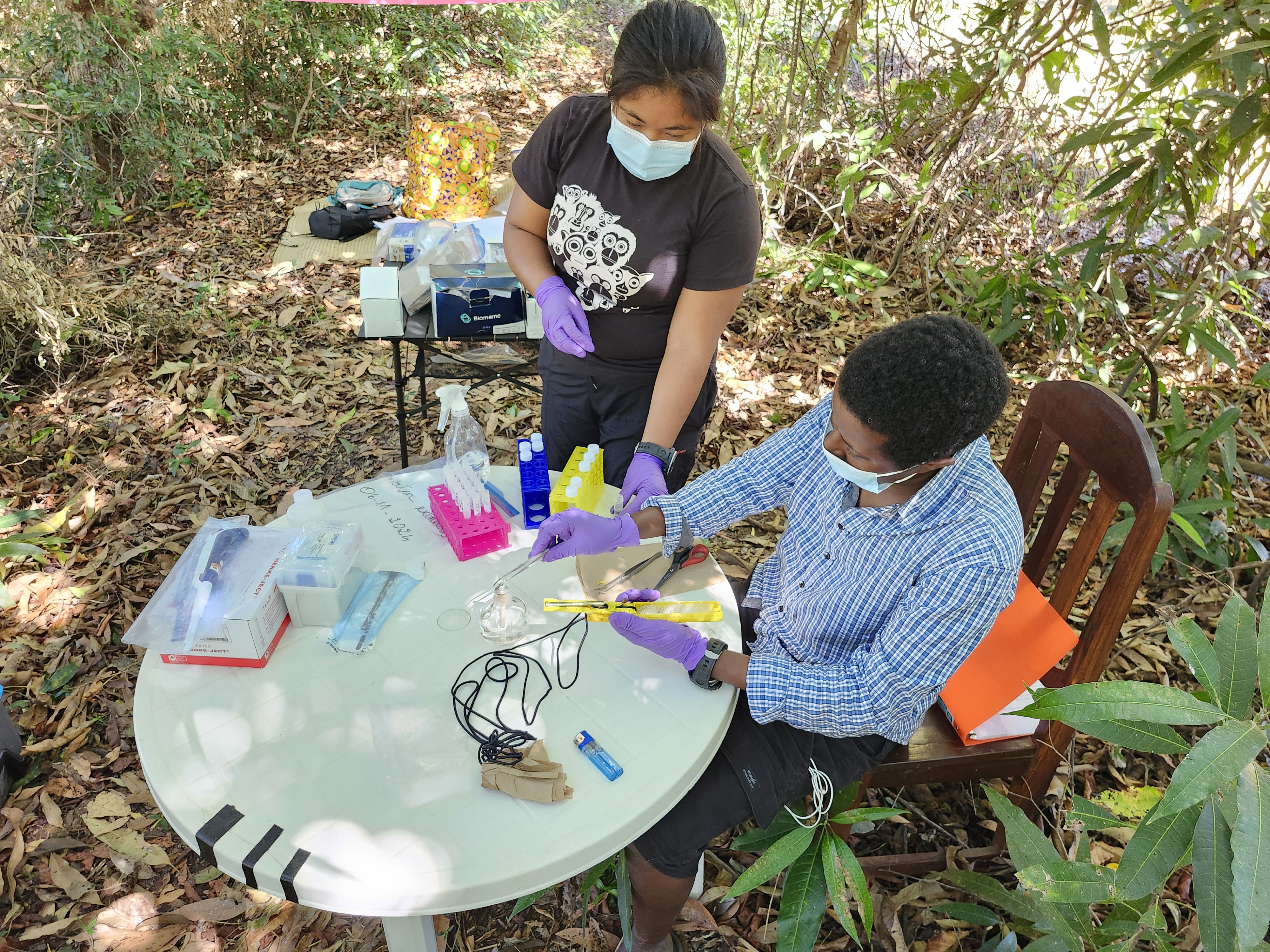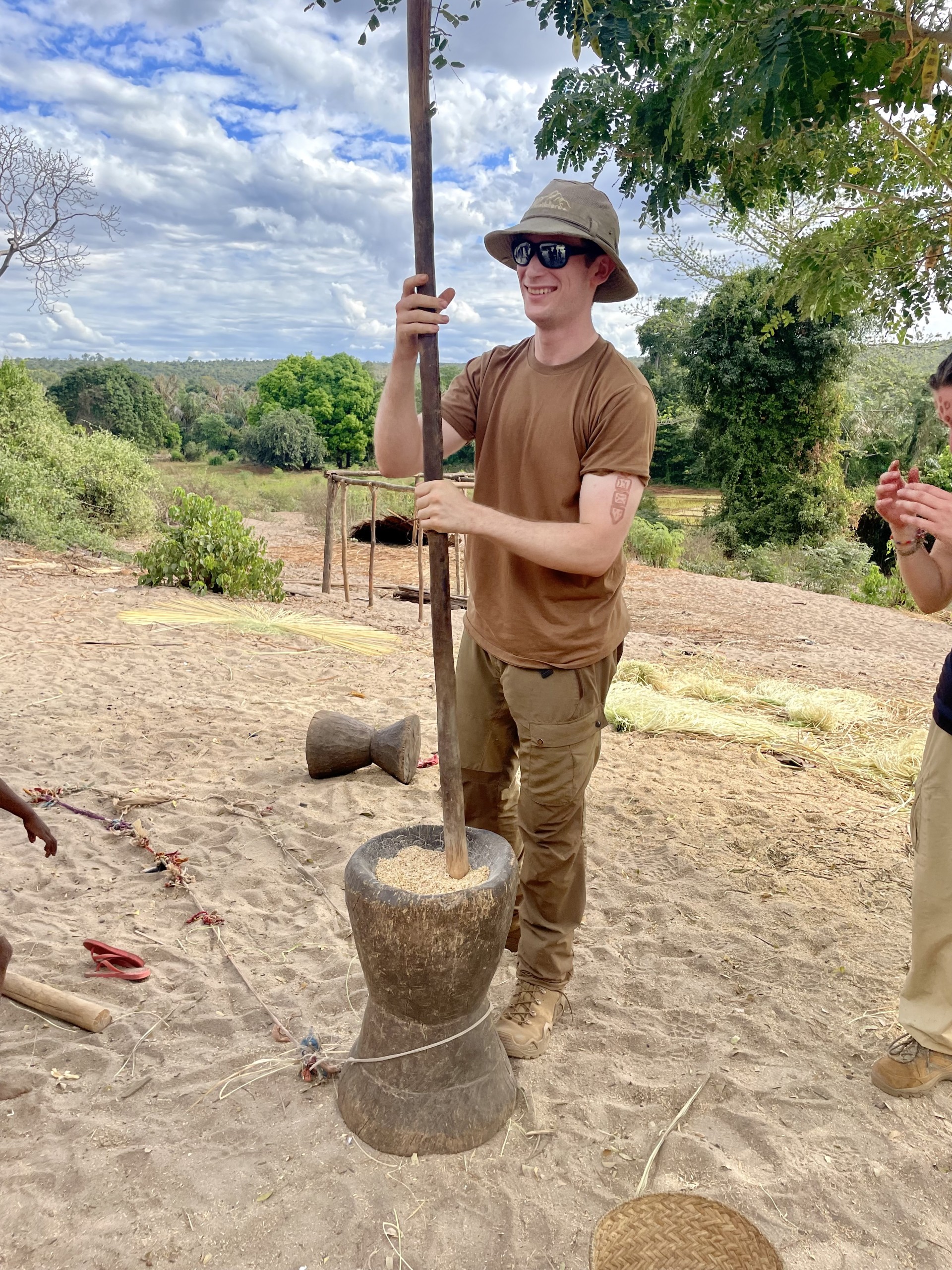In the vast lands of Madagascar, researchers describe a “tragedy without villains” – lemurs are disappearing from forests that are shrinking.
At the Ankarafantsika National Park in Madagascar, lemurs live among humans in a place considered their last refuge. As the most endangered animals in the world – 98 per cent of over 100 lemur species are threatened – without intervention, most lemurs are predicted to be extinct in the next 20 years.
Protecting these primates drives a unique research project at the University of Guelph. Dr. Heather Murphy and Dr. Travis Steffens travel from Guelph to Africa to prevent these endangered creatures from contracting zoonotic diseases from the humans and livestock sharing their environment.
“The next pandemic will be a zoonotic disease transmitted from animals to humans,” Murphy, a pathobiology professor in the Ontario Veterinary College, says. “Studying these systems helps us understand how disease is transmitted, which could, down the line, help prevent future outbreaks.”
The methods honed through this project will apply to other parts of the world, where people live in close contact with animals and where disease spillover is a distinct risk.
“There are 5 billion people on the planet who live within 100 kilometres of primates,” Steffens, an anthropology professor in the College of Social and Applied Human Sciences (CSAHS), says. “Understanding diseases in these contexts is a public, global issue we need to consider.”
Though the project has global impact, it began on a more intimate scale, with the death of an eight-year-old girl who lived at the park.
“She died of a simple respiratory ailment that a small amount of antibiotics, given two weeks earlier, would have fixed,” Steffens says. “That’s where the One Health approach came from. We can help with the community’s health and the lemur’s health because they share the same environment. They’re completely connected.”

(Photos by Dr. Travis Steffens)

One Health breaks barriers in Madagascar
One Health, the study of how humans, animals and the environment interact as part of one interconnected system, is key to this first-of-its-kind project.
“Traditionally, many studies have worked in silos focusing on either animal, human or environmental health,” Murphy says. “The One Health approach lets us combine thinking and expertise across disciplines.”

Where some would simply build wells to address the community’s problems, for example, the One Health researchers investigate the system as a whole. Murphy seeks to understand the transmission patterns of pathogens between humans, livestock and lemurs and to ultimately develop interventions to improve lemur conservation and human health. Steffens, an anthropologist, works to ensure these strategies are culturally relevant to the community living in the area and impactful for the lemurs.
The key goal, then, is a map of the pathogens that might be present, as researchers extract DNA from biological samples while tracing transmission routes and areas of risk.
“What are the most common pathogens?” Murphy asks. “Are they coming from the water or from animal or human feces?”
Similar questions would apply to the lemurs as well.
“Are lemurs getting sick because there is a lot of animal feces around contaminating their water supply? Or are they getting sick from interacting with animals/humans or their feces?” Murphy says. “How do we stop those transmission routes?”
To begin answering these questions, researchers take a day’s worth of flights and an 11-hour drive to reach the park. There, thick tropical forests are interspersed with several ecosystems, creating a hot spot of biodiversity that’s home to hundreds of animal species.
The park is home to humans, too. About 30,000 people, spread across over 100 villages and hamlets, share the landscape intimately with domestic and wild animals. Children play with lemurs and run barefoot in the park. All groups – animal and human – use the same river that runs from one community to the other.
This puts the predominant ethnic group, the Sakalava people, at risk for disease. The Sakalava settled in the region thousands of years ago and now face extreme poverty. While many aim to live sustainably with their environment, some have turned forests into rice fields or into charcoal to cook their food in order to survive. Over the years, this has caused the forests to shrink and lemurs to get in closer contact with humans.

Climate change plays a large role as well, creating warm conditions perfect for pathogens and increasing the risk of cross-contamination.
Almost all the pathogens the community is exposed to cause diarrheal diseases, Murphy says, which leads to chronic, irreversible malnutrition in children.
Though part of the project aims to mitigate this public health crisis, its education component is critical: How do you get people to think about the risks of disease from animals? With no running water, how might you improve their hygiene and sanitation?
“There are very strong cultural components to the project,” Steffens says. “We have to understand how people think about disease and the forest.”
“For example, we know handwashing would make a huge impact, but people do not want to wash their hands there,” Murphy says. “They think it is something foreigners do. Instead, we ask: Can we focus on one intervention for one key time – for example, washing hands just before they eat? Can we get local leaders in the community on board?”
She adds, “The social and cultural considerations our student is investigating are helping us figure out what’s possible.”
One Health a ‘wake-up call’ for PhD student
Dr. Amilcar Bisekere (DVM), Steffens and Murphy’s PhD student, was drawn to the project as it reminded him of his home in Burundi, East Africa. There, he saw village workers dumping animal waste from slaughterhouses into the river. He always wanted to stop this practice, somehow – to educate people on safer practices so that he might see the rivers of his home clean again.

When he came to U of G and learned about One Health, something clicked.
“It was a wake-up call,” he says.
Bisekere now sees parallels between the people in his home and the people in Madagascar, both able to benefit from just a little education and advanced pathogen monitoring.
“One person said he doesn’t need water treatment because he’s grown up drinking this water,” Bisekere says. “But then I told him, ‘Can’t you see your kids are getting sick?’”
In the 30–35 C heat, Bisekere travels by foot through the forests to collect various samples and survey the community to learn their habits and practices, their understanding of disease and their relationship to domestic and wild animals, including lemurs.
“What we kept seeing from the community was the lack of clean water and the lack of latrines,” Bisekere says. “Clean water would solve a majority of these problems, but the situation is also more complex.”
Working with Dr. Elizabeth Finnis, a sociology professor at CSAHS, to hone the sociological understanding of this community, Bisekere, a Blake Graham Scholar, says that he is grateful for the international collaboration empowered by One Health. From Canada, collaborators include Dr. Marek Smieja at McMaster University and Dr. Scott Weese at U of G, and from Madagascar is Dr. Brigitte Raharivololona, a primatologist and lemur parasitologist. He also works with community members and students at the local university throughout, all of whom are essential for the project.
He says, “My vision is to build a One Health approach framework to find solutions to global health problems in developing countries, especially in the human-animal-wildlife interface.”
Behind the research: Community rebuilding and experiential learning
Bisekere is among many U of G students studying in Madagascar, thanks to a field school set up by Steffens. Those taking advantage of the experiential learning opportunity, including master’s student Hunter Rusk, describe the experience as life-changing.

Steffens began the field school when he noticed how difficult it was to gain primate research skills in Canada. Not only does the field school prepare the next generation to work in the field, it also increases research capacity throughout the country.
“Madagascar has a very robust primate research community,” he says. “The school is a way we can support and give back.”
In addition to the field school, Steffens runs a charity called Planet Madagascar, which he co-founded after realizing how far his research funds could stretch.
“Madagascar’s GDP is $15 billion a year, whereas Apple will probably report $60 billion in revenue this quarter,” Steffens says. “One company could cover the entire cost of every person in that country for years.”
Planet Madagascar supports this project along with Murphy’s Tier II Canada Research Chair in One Health and U of G’s One Health Institute. It also leads a host of community development projects, building schools, beekeeping infrastructure, nurseries for local trees and much more. These initiatives not only help to regrow the shrinking forests but set the community on a path towards self-resiliency.
As for the lemurs, Steffens is hopeful their research will also translate to long-lasting impacts.
“We think we can bring one or two of the lemur species down from critically endangered to endangered,” Steffens says. “We think that we can improve community health and sanitation through this project, and we think we can replicate it around the park, reaching 100,000 people.”
Steffens and Murphy’s ambitions involve expanding the project to save more animals and help more people.
“We want to go bigger, better, further, stronger,” Steffens says.
